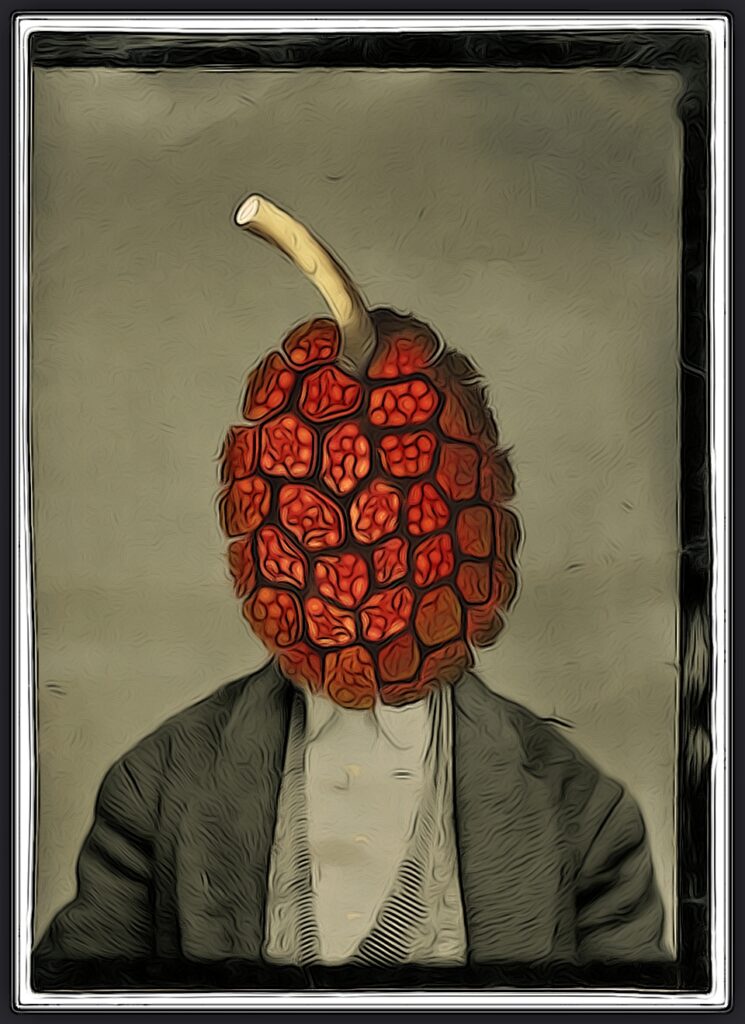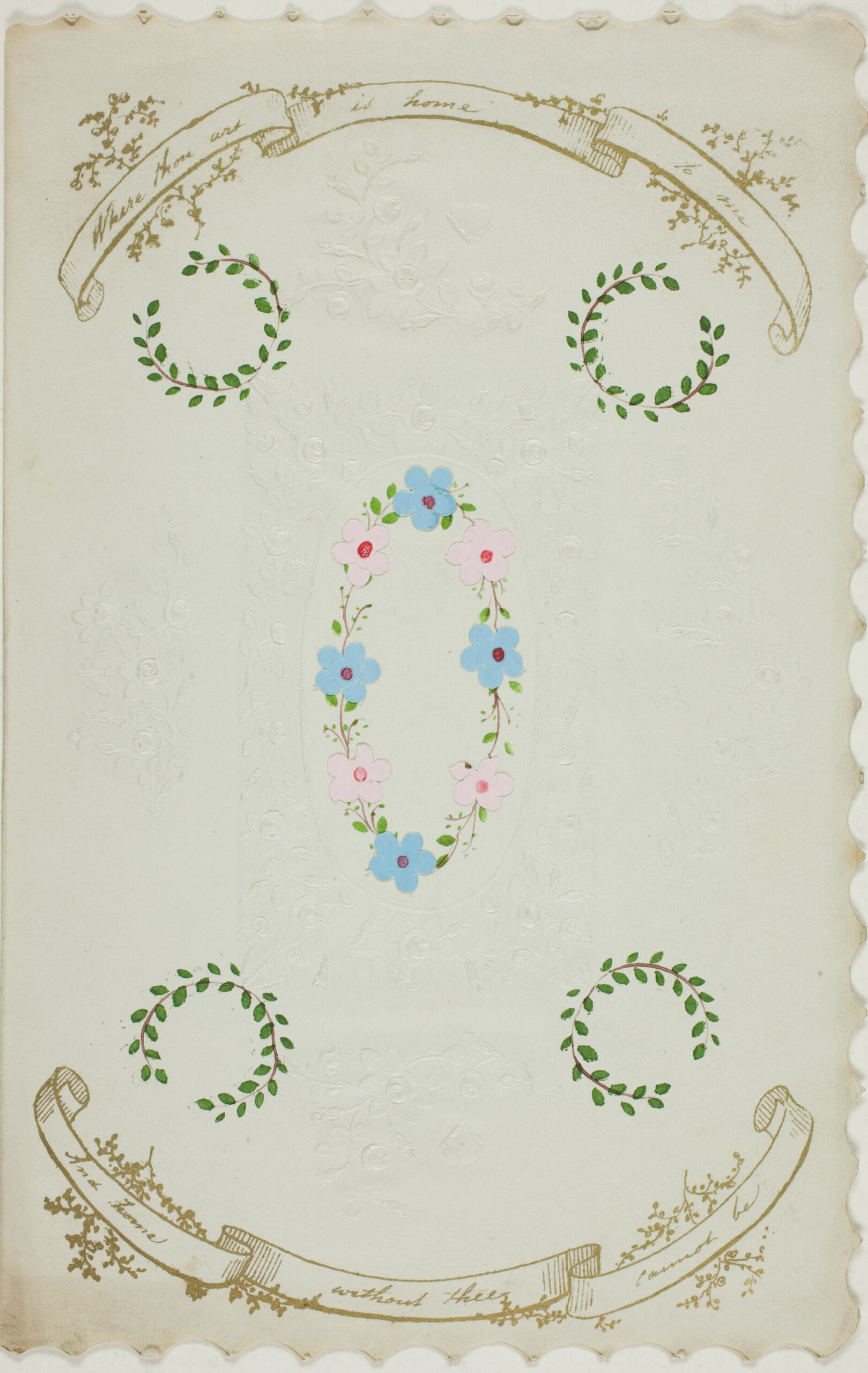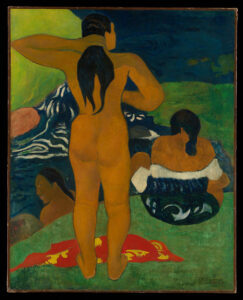Learning to eat: an essay in twelve dishes and one dinner party
Éireann Lorsung
—S U G O—
The kitchen window looks west over the garden: almond tree, fig trees, apple trees, plum trees, mulberry tree. There are containers of basil on the sill. The room itself is a dingy cream color, paint with too much yellow pigment in it to ever look truly clean. In an alcove, where there once was a wood-fed stove, the huge gas stove and oven sits. Even in the winter, this room is warm. Someone is always eating something here. The woman who lives here makes bread every day (sometimes twice). In the evenings, the family eats late. They have made their own Italy inside of England: fruit trees, late dinners, an abundance of lemons and coffee and aromatic herbs, thrown phrases in a Roman dialect.
One of the meals I have with them frequently is a simple pasta with red sauce, which, in this house, is never “red sauce” but sugo rosso, or just sugo. It consists of a few cloves of garlic sliced into large pieces and fried in olive oil until they have perfumed it, then a tablespoon or two of fish sauce poured into the pan, followed almost immediately by a jar of passata and a can of chopped tomatoes. It simmers for twenty or thirty minutes, just enough to take the acidity down. The fish sauce adds a pungent undertone. It tastes deep but fresh. Sugo (the sauce is mythical and comes to stand in for all sauces in my mind) is salty, tomato-y, rich because of the fish sauce (which does what anchovies are sometimes called to do in sauce). She cooks rigatoni and ladles the sauce into the pot of drained pasta, coating it lightly. Grated parmesan on top, a delicate tumbler of red wine, some olives. The sky is light until ten p.m., and the kitchen smells like tomatoes and yeast.
—S T O L L E N—
In the German-speaking house of my father’s grandparents, in a room with a seven-pointed star inlaid in the floor, looking out over the white-gray-tan-brown-white landscape of December, a tree would be set up and the doors closed so the children couldn’t see it until dark had fallen, Mass had been attended, and the candles, in their little brass holders like carriage lanterns, had been lit. My father’s memory of that house is cream straight from the creamery in the summer. My memory of it, a few years before it was demolished and its Christmas Eves were buried in landfills or stripped for zinc and copper, was emptiness and ruin.
In Düsseldorf, visiting a friend just before Christmas one year, I see brass candle holders like my great-great-grandmother’s and I realize that how my father’s people lived was a memory of where they had come from. Neele and I sit in a busy café, and the smell of bread and coffee and snow swirls around us; Jonathan comes to find us, carrying a piece of stollen in a yellow bag. The stollen is dense and a little dry, thick with almond paste and powdered sugar. I am caught between central Minnesota’s landscape of water and wheat stubble and the now of Düsseldorf as flurries pick up and the lights come on in the street. My grandmother makes soft rolls with oat flour as her mother pours cream carefully into a bowl of whipped eggs as her mother lights candles on the tree in the room with the seven-pointed star, as candlelight reflects off brass.
—G E L A T O all’ A M A R E N A—
As long ago as 300 BCE, in southeastern Europe and what is now Iran, Afghanistan, and Pakistan, people were cultivating Prunus cerasus, sour cherry. Cherry trees arrived in Rome from Persia around 68 CE, and by the first century CE the Romans had brought the trees to Britain and elsewhere. But during the Middle Ages, the cherry fell out of cultivation except in monasteries. Cherry cultivation picks up again in the 1600s, the trees grown for their fruit and their wood, which is used to make musical instruments. The most common variety grown now—in nurseries and orchards from Iran to England—is Morello, but other varieties continue to be propagated. These include Kentish Red, which was brought to what is now the United States in the 1620s by colonists, and Schaarbeekse Kriek, a rare Morello variety used to make self-fermenting beer, known as lambic, in Belgium. Planting fruit trees feels like being rich to me: the possibility of making our own jam, of having frozen fruit in January to fill cakes and add to yogurt.
Some people don’t care for sour cherries, and prefer the larger, sweeter varieties. But as a grower in a cool country, the tartness of the fruit is offset by how well the trees produce and how well they suit the climate; they are self-pollenizing, grow well, and tend to flower late, avoiding the risk of frost damage and consequent loss of crop. Cooked with sugar, sour cherries transform into the epitome of summer days: their flavor is warm and full, sweetness complimented by a sharp edge. But I can tell you facts about sour cherries all day and it won’t get you any closer to the hot afternoon at the end of May, surrounded by the ochre and tawn of Rome’s walls, when we stopped at a gelateria built into the corner of a restaurant. I had sour cherry gelato: not the more common gelato all’amarena (cream-flavored ice cream with sour cherry jam swirled through it) but an actual ice cream fully flavored with the cherries. It was dark pink, smooth, a contrast to the dusty and dry day. So tart I could have eaten five-times the amount, sitting on a stone wall across the piazza in the shade of a church. The ice cream tasted like first cherries, not bought in a supermarket; like sun on fruit. We went back a few days later, but no more sour cherry ice cream. They had run out, and the cherries were going out of season.
We planted two cherry trees, both naturalized and old Belgian varieties. If the birds don’t get the crop, I will make a small amount of sour cherry ice cream, first cooking the cherries lightly with a bit of sugar, then puréeing half, then folding both through the half-set cream and freezing, to serve with thin, buttery waffle cookies—an Italy for us in our Belgian surroundings.
—E A T I N G with the E C O N O M I S T S—
If you are lonely when you arrive in a new country, and if you can bear it, I suggest cooking for people you have just met. Make yourself indispensable to them by the provision of food.
It is 2007 and I move to England, where I live in dismal shared accommodations. The kitchen is always dirty, the stove only has two working burners, and one of my housemates leaves raw meat on the counter until it smells. Every Tuesday afternoon, I leave work early and go to the grocery store. I buy things for experimental recipes and recipes from home; I buy flour and eggs and plan new desserts. Then I clean the kitchen and prepare the food and set the table, and about seven p.m. the economists show up with their three pounds for dinner. They have come to the university from all over the world; their group’s bond is departmental affiliation. I belong by virtue of living near a few of them. What my labor buys is conversation and group membership (and someone to do the dishes). We spend most of our first year this way, and when our weekly dinners disintegrate it is because we have all found other places to belong. Nevertheless I often think back to memorable Tuesdays with them, all of us around the long table, passing around carnitas or tuna casserole or eggplant parmigiana, talking over one another and making jokes, everyone both out of their element and, for a few hours at least, really at home.
—P I Z Z A Q U A T T R O F O R M A G G I—
July: Venice. In a back room of an art school hidden behind sottoporteggi and climbing, red-flowered vines, the air smells of old churches and turpentine. In the full sun at noon, old men sit at cafés with tiny cups of espresso; the wine merchant opens the upper half of his door, showing the barrels and their spigots, calling out to one or another passerby to bring a jug or a bottle or an old glass jar and fill it there with red wine; the sun heats the bricks that cats laid on all morning, too hot now to touch with bare feet; tourists fill the cross-street, and the gewgaw vendor twirls whirligigs under a striped awning.
Duck down Calle de l’Aseo; there is a little pizzeria there. One euro for a slice of margherita. One euro fifty for quattro formaggi, the four cheeses blending perfectly with the oil and oregano and tomato sauce, the blue cheese’s dirty note picking up the acid of the tomatoes. The shop is too small to sit in, although you can perch on the open window. But I carry my slice with me, buy a nectarine (“Non toccare!” says the vendor to every passing tourist who wants to put their hands on his beautiful fruit), and eat in the shade of the school’s inner court, where tiny green-blue lizards run the walls, and the day’s heat sweeps in on air from the street, smelling of flowers and canal, bodies, food, and wine.
—O N I O N C A R R O T C E L E R Y—
“Don’t put your fingers like that,” Kao Vang says to me. “You’re going to chop them right off, man.” Kao is my roommate Jenny’s boyfriend, but more importantly he is the sous-cook in the dormitory kitchen where I’m working, and he knows much more about cooking than I do. The head cook is grumpy, shouty, and impatient; he sends trays of undercooked chicken legs up to the dining room, because for him a line of students out the door, clamoring for food now, is worse in the short term than a few with food poisoning later. It is impossible to learn enough to please him. So I tag along behind Kao and try to do everything just like him. Kao gives me a huge blue plastic crate of white onions—their skins already removed—carrots, and celery washed and topped. My job for the next two hours will be to chop these, portion them out, and deliver the portions to the cooking stations. “Extras go in the fridge, here,” says Kao, and he shows me the shelves reserved for industrial Tupperwares of chopped garlic, onions, carrots, celery. Once I’ve begun chopping, Kao takes the knife to show me, again, how to hold my fingers. “Curl them under,” he says, “like this.” His fingernails are cut low and straight. He slices the onion confidently, and the pieces fall one after another onto the green cutting board. This is the best time of day in the kitchen, because the head cook isn’t there yet: it’s me and Kao Yang and José (another sous-cook), and they sing along with the radio, taking breaks to smoke a joint out behind the dorm as casually as if it were a cigarette. I chop and chop, and I don’t cut off any part of my fingers. When I go home after work, my shoulder joint aches. My hands smell like celery and onion. Later in the year I get transferred to dishwashing, and come home stinking, covered in particles of ketchup and gravy, hot and sweaty and humid from the steam. I watch through the dish room’s windows as José and Kao joke around, making the chicken legs dance on their trays. The new kitchen assistant is a tall kid from Idaho, whose height gives him good leverage on the cutting board, and whose left hand curls professionally on the onions from his very first day.
—I R I S H B R E A D—
In an undated photograph from the early 1980s, I am standing on a high stool next to my mother. My hair is cut in a bowl shape and my toddler hands are chubby and dimpled. My mother’s hair is pinned up with one big clip. The kitchen doors are shut, and that means the room is warm: it is March, and March in Minnesota is still the middle of winter. The neighbor’s maple is bare and dark against the house and sky, and dusk is coming down. In the kitchen, yellow light emanates from a hanging lamp with a tin shade marked with punched-out stars, and my mother’s hands work dough on a cutting board pulled from underneath a counter.
My mother is making Irish Bread for breakfast tomorrow. My job is to help push the raisins in. With two fingers, I take a pinch of butter, then press the raisins—which are incorporated with the dough—deep into the loaf. This ensures that the crust will have a pleasantly dimpled texture, and that the raisins will burn as little as possible. My mother bakes the loaves of Irish Bread in heavy cast-iron pans, and when they come out, fragrant, steaming through invisible fissures in their crusts, she tips them onto wire racks on the largest, pulled-out cutting board. You can eat the bread right away, with salty butter that melts into it, but I have always preferred it the next morning, the raisins punctuating the slightly dry crumb, the soft crust crumbling in the mouth, each bite carrying a little raft of chilled butter.
I remember waking up once, after my mother baked this bread—on a weekend, probably, and I was a teenager by this time—and outside the world had gone back to winter. Inches of snow covered the yard and roofs. The white Christmas lights that decorate my parents’ windows were on, and the gray sky promised more of everything: more snow, more little lights, more of the soft, dense bread, more books to read at the table, more time, forever, nothing ending, a perpetual afternoon of mother-love manifest in baked goods and the intemperate spring weather of the upper Great Plains.
—L E M O N—
Lemons, like cherries, come to Europe early in the Common Era. Where from, exactly, remains a mystery. Maybe India. Maybe Burma. Maybe China. But by the first millennium CE their cultivation is distributed widely across the whole Mediterranean region, including Egypt, and throughout Persia and Iraq. Lemons appear in a tenth-century Arabic treatise on farming and are used in Islamic gardens as decorative plants. Like cherries, lemons are later spread in part by colonization: they travel with the Spanish explorers and are tended by enslaved people and colonist settlers in the Americas. Serious cultivation in Europe begins in Italy in the mid-1400s, and by the end of the twentieth century lemons are grown for industrial use and in mass agriculture in Guatemala, southern Mexico, Argentina, Chile, Italy, Greece, Spain, Turkey, Cyprus, Lebanon, South Africa, Australia, and the Philippines. The United States’ citrus industry—concentrated, no pun intended, in Florida, California, and, in the mid-twentieth century, Arizona—suffered from foreign competition on lemon prices and now consists primarily of orange groves.
Pablo Neruda, in Odas Elementales, calls a cut lemon “dos mitades/ del milagro,” two halves of the miracle. The miracle itself, like most miracles, is difficult to put your hands on. (Neruda also writes odes to his socks and to tomatoes and to wine, the sea, onions, artichokes, all implicated in the total miracle of everything.) The body of the lemon, cut, releases its aromatic oil and its acidic juice; it catches light along the facets of its vesicles. It is a fruit for all the senses.
The lemon is unpleasantly acidic to some people—cultivars like Citrus x meyeri reduce the sting—but ever since I was a very small child I have enjoyed eating lemons raw, despite the tingle at the tips of my eye-teeth when I eat too many.
—P I G E O N ( D O V E )—
It is a truth universally acknowledged that one should not undertake an overseas voyage with one’s ex, no matter how cheap the family-rate airline tickets are. But my brother and his ex-girlfriend decide, nevertheless, to visit me in France over New Year’s. I have been working as a teacher in a small town not far from the eastern border, where there is not much to do in the hours when I am with my students. After two days, my guests’ patience with one another is gone. They snip and bicker, and for the ten days of their visit, my one-room apartment crackles with their refusal to work things out. Noah doesn’t want to eat anything but pains au chocolat, but he refuses to go into the baker to ask for them. But, I think, if we can just hang on, all will be well: it is New Year’s Eve, and we are invited to the house of my dear colleague for dinner. He and his wife are funny, generous, and very kind. I am sure the atmosphere will diffuse some of the tension that’s so concentrated in the apartment, and the adventure of new foods in a very French setting will please my brother and Rachelle.
The table is set and Sandra brings out the first course: avocados with crab salad. Everything is fine. My brother, sitting next to me, doesn’t eat much of the crab, but scrapes his avocado skin empty. He perks up considerably when he realizes that in France, he’s of age: he’ll be served wine and other alcohol along with the rest of us. Sandra gets up to take the main course out of the oven; Jean-Marie goes to help her. There is some complicated-sounding shuffling, and then they return with our plates, on each of which there are potatoes, roasted carrots, and a whole, perfect dove. The feet are still attached, curling, purplish, as is the meat. I see my brother blanch. He is not a meat-eater at the best of times: soft for animals, and uncomfortable with the connection between death and dinner. He really does turn pale; in fact, I think he is going to throw up, and hiss-whisper for him to go to the bathroom. Rachelle is making deft work of hers, chatting to the other guests in a charming mixture of French and English. Noah looks like he is going to cry. “Just eat the vegetables,” I whisper, hoping our hosts haven’t noticed. “But they’re touching it,” he whispers back. The contents of this room—Rachelle’s animated conversation; Noah’s inability to use the little French he knows; the unfamiliar smells, the late dinner, the wine and Champagne; the meat so clearly and recently a bird lying on my brother’s plate—are too much. I can see the tears standing in his eyes.
Later that night, waiting for Jean-Marie to drive us home, we stand outside. The countryside is dark around us. The sky is very close and very full of stars. The air is cold. I give my littlest brother a sideways hug, and we shiver. Tomorrow is a new year. We will walk to the bakery early in the morning, just us, and I will ask for the pastries he points out, and buy them for him.
—U D O N—
Lest you think I was born with an adventuresome palette, or even a desire to try the unfamiliar, let me tell you about the first time I was in Japan, when I was eighteen. My father had just started working for Northwest Airlines as a lobby attendant, which carried the benefit of nearly free flights for family members. I had been studying Japanese for five years and was preparing to enter university as a Japanese major. Now I would finally be able to see that place and be surrounded by that language. I barely slept on the twenty-hour flight, listening to CDs on repeat on my Discman.
Kansai Airport was smudged with acrid cigarette smoke, a scent very different from American tobacco, and busy with announcements and placards I couldn’t understand. It was August: humid, hot, rainy, and foggy. From the back of my friend’s family’s van, I watched the landscape pass along the highway. We walked into the house (“Tadaima!” she called, and her mother came out of the kitchen and gave me a hug, and I was surprised) where it smelled like cooking and clean floors and mosquito coils. An hour later it was dinner time. I sat at the table, which was covered in a plasticized cloth, and my friend’s mother served udon in a clear broth into glass bowls. Jet lag made my stomach sour and my head woozy; I just wanted to go to bed—in my own bed—and eat a familiar breakfast after sleeping twenty-four hours. When she set down my bowl of noodles in front of me, the white, fat udon swimming in a delicate broth punctuated by slivers of green, all I could think was worms. I was ungrateful, exhausted, lost in a language that exhilarated and frustrated me, and as I tried to pick up the noodles with my chopsticks, I burst into tears I couldn’t explain.
Later I would eat eel sushi and pickled plums and rice balls and thin slices of beef cooked in broth and served with onions over bowls of white rice; I would eat steamed fish and pancakes with bacon and cabbage. I would eat gray soba noodles with salty, sour dipping sauce in dim department store basements. But it is those first noodles, cool and slippery in their clear broth, that teach me, over the distance of more than a decade, not about how or what to eat, but about how to be a guest.
—O L I V E S—
Even as a child, I had a sense of things from the outside. I remember in first grade, in line with my class, feeling unsure whether I was in my body, walking up the stairs on the right-hand side of the hall, or whether I was in another body, one of the children descending the stairs on the other side. Same for certain rituals and repetitive occurrences in our family: even as I participated in them, I knew that they were the building blocks of ritual and that they contributed to what I would remember about being a child. At the same time, parts of my childhood—very ordinary things—took on mystical, almost religious significance. One of these things was olives.
Before retiring and becoming an airport lobby worker, my dad worked as a teacher in the public school system. He biked to work most days. When he didn’t, he took the bus, and I remember all of us going to pick him up in the huge old Ford van my parents bought around the time I finished middle school. On his commutes, my dad would stop and pick up interesting things he found in the street: sunglasses for my mom, a cashmere scarf. And sometimes he would have to go to the district central building, in which case he would stop by Bill’s, a place my brothers and I knew only by name. From Bill’s came the most delicious, salty, dark purple-brown kalamata olives, doled out on summer afternoons, sitting on the back porch with a coveted glass of tonic water. Bill’s was part of the mystery of adulthood, a place for the grownups to go, from which the grown-up taste and texture of olives came.
All through university, my dad would stop by my apartment unannounced, with a bag of kalamatas from Bill’s. Recently when I’ve gone home, he laments repeatedly the fact that the grocery store he goes to doesn’t stock that variety; I don’t have the heart to say I don’t mind, that the past can stay the past, that he doesn’t have to buy me olives anymore.
—T E A—
There are ten of us and we take up the huge middle table at Shuang Cheng about once every two weeks: computer science majors, chemistry majors, pre-med students, physics majors, and me, studying Japanese. We talk too loudly, share a lot of food, then walk back late at night, crossing the river on the double-decker bridge we take for granted. All through dinner, we drink the strong jasmine tea that the restaurant serves in metal teapots. We drink it straight or with sugar; we occasionally pour equal amounts of sugar and tea into our cups. We are all 19 and we are immortal and wild and hormonal. The taste of that jasmine tea is complex—floral and industrial, delicate and over-strong. We have our own bank accounts now. We can pay by check. When I knock a full teapot off the table, I catch it in one thoughtless movement and the boiling tea burns the back of my hand and my wrist, while the teapot itself burns my palm. I don’t even think of calling my mother, just clench my teeth, smile tightly, and walk as fast as I can to the bathroom to run water over it. I report for work—washing dishes in the dorm kitchen—all week despite the burns. This is what being grown-up means, I think: bittersweetness and burnt flesh and a rubber glove to cover the pain, and the heat penetrating anyway.
—C H E E R I O S—
For almost eight years, and almost without exception, I had a bowl of Cheerios and a cup of strong, milky tea for breakfast. If I have to work to choose food, it is likely I will choose not to eat, or just wind up not eating. At lunch I motivate myself by making something warm or spicy. Dinners are easy, because there is usually someone else there, whose presence is a tacit demand for decisions about what to eat. But breakfast? I don’t want to make decisions about breakfast.
In spring and early summer 2009 I was hardly eating. In fact, throughout most of 2008 and up until summer 2009 I was hardly eating. (Food and what Leslie Jamison refers to as “melodrama,” when she writes about female pain, especially girls’ pain, go hand in hand.) I was in a relationship without any stability. I was afraid and unable to move. I couldn’t make decisions. I lost all sense of hunger; there was nothing that appealed to me, or food that did appeal lost its appeal as I brought it to my mouth. I lost weight. Food, except for very vinegary food, spicy food, and fruit, disgusted me. I wanted to sleep all the time. I was clinging to my sense of self, which evaporated in front of my eyes: part of how I’ve known myself since I was little is as an eater. I have always liked food, and have always eaten more than people expect from someone who is short and slight as I am.
When that relationship was definitively over, I would wake up every day angry that I had to begin again, yet again. I had to relearn how to breathe. How to get out of bed. How to feed myself and shower and go to work. I decided two things at some point that summer: First, I was tired of bending over backwards to make myself available. People would have to come to me now. And so my friends filled my house and made it theirs, sleeping on spare beds and the couch, working in the garden, cooking together. Second, I was going to eat whatever felt good. I was not going to worry about health or cost; I was going to worry about getting enough calories to live. I ate clotted cream on scones. I ate as many strawberries as I wanted; some days only strawberries, until my mouth hurt. I ordered takeaway Chinese food. Made enormous plates of spaghetti. And I bought a box of Cheerios in the supermarket—having not eaten them since I was a child—because they looked good and I was willing to try anything that actually appealed. Eating Cheerios for breakfast became a comfort over months filled with deep, warm friendships and gardening and moving into the house that would be my own.
Then, one morning a few years ago, I woke up and ate the last bowl of Cheerios, folded the box into the recycling before walking out the door to take a flight to Mexico City, where I would meet a friend over spring break. Walking through a city I didn’t know with my friend Andrea, it occurred to me to try to make granola—something that had never sounded good to me. She handed me a piece of bread kneaded through with pecans, a specialty of the place we had traveled together, and I thought, I want to remember what it is like to walk through this place with her, talking about ideas, looking at all that is beautiful; and I want to make it myself. I thought of all the times I had carefully made meals for strangers and for family and the pleasure of knowing I had prepared their food with my hands, my mind, and my own attention and care. When I get home, I thought, I will mix oats and nuts and coconut, salt and cinnamon, vegetable oil and maple syrup, and make a breakfast exactly to my taste. I will learn to feed myself anew, from these days spent walking here.









